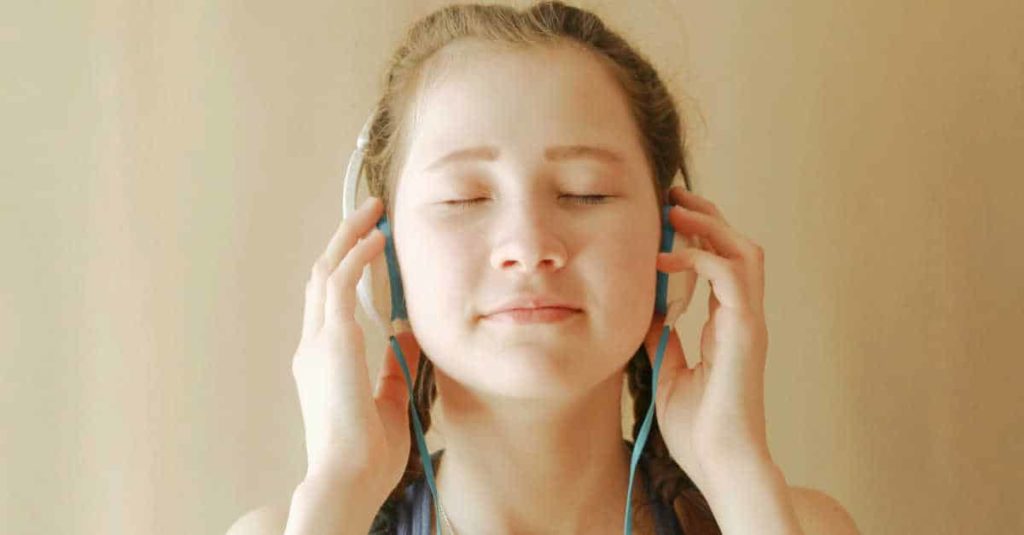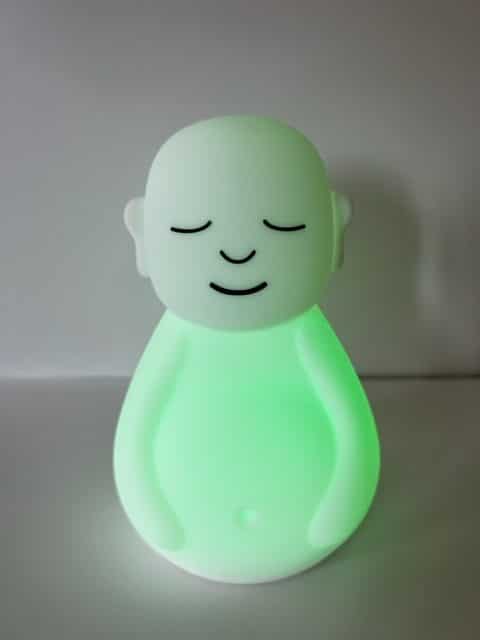Inside: Teens can benefit from a mindfulness app because it can be a powerful tool for teaching teens coping skills and can help combat the rising epidemic of teen mental health issues in today’s world.

Mindfulness for teens is an important topic to address with them as they age. Being a teen in today’s world is stressful. There are so many pressures that teens are dealing with at school, with their friends, and even in family relationships. Mindfulness is an amazingly powerful tool in helping teens to cope with the challenges they face and to manage teen mental health issues. Since teens love being connected through all things technology, using mindfulness apps for teens can be an effective way to get teens to practice mindfulness techniques.
Research has shown that teens who consistently practice mindfulness experience lower rates of anxiety and depression. Mindfulness also leads to better sleep, stronger relationships, and increased self-awareness, which all benefit a teen’s overall health and happiness.
Technology often feels like the root of many teens’ troubles, but giving them a chance to use mindfulness apps allows them to use technology is a positive way. Sometimes, it’s just a matter of helping our teens find ways to use the screens in front of them better.
What is mindfulness?
Before downloading the suggested mindfulness apps for teens, you may have to help your teen understand what mindfulness is and why it’s something they should consider. It can be hard to teach a teenager mindfulness without them fully grasping what the concept is.
According to the Wharton Neuroscience Initiative at the University of Pennsylvania, “Mindfulness meditation has received the most attention in neuroscience research over the past two decades. Behavioral studies suggest that mindfulness mediation provides beneficial effects on a number of cognitive domains, including attention, memory, executive function, and cognitive flexibility.”
Being mindful is taking the time to be aware of your surroundings, yourself, body, emotions, actions, and thoughts. It can be as detailed as taking in the noises around you or slowing down and enjoying the peace and quiet.
Related: How Guided Meditation Helped Me Grow Closer to My Energetic Tween Son
During most of their days, our kids are often so busy rushing from one thing to the next that they completely forget to stop and think about how they’re doing at that moment. Sometimes this goes on for weeks or months, and they don’t even realize they are struggling emotionally or running themselves into the ground.
Additionally, adolescence is a time when teens rapidly develop emotionally, physically, and socially. This makes things like mood swings, negative thoughts, low self esteem, and other issues more prevalent.
These issues combined can lead to much bigger problems, such as panic attacks, chronic anxiety, depression, and other mental health issues. Teaching your teen to take the time to understand how they are feeling and what they can do to improve their mood is an important part of self-care.
This is where learning about mindfulness can be helpful. It teaches teens to check in with themselves, be more aware of their feelings, and then use their own breath, self-talk and even positive affirmations to stabilize and find inner peace and calm.
What do you need to know about Mindful Meditation?
When we first started learning about mindful meditation and how powerful it could be for mental health, this video from Diana Winston, director of mindfulness education at the UCLA Mindful Awareness Research Center (MARC) helped us grasp the concept.
Simple Ways to Become More Mindful
Most teens today don’t know how to stay present. They rush around from activity to activity and when they do have a free moment, they often scroll through social media or watch mindless videos. There are a few ways to teach your kids to be more mindful.
These include:
- Slowing down when eating, thinking about how your food tastes, and having your meals without distractions, such as TV, electronics, etc.
- Set reminders to stop what you are doing and take a few moments to notice how you are feeling.
- Take three deep breaths several times during the day.
- Journal their feelings (many psychologists recommend teens journal regularly so they can better understand their emotions.) Moodtrack is an awesome app to help your teen track their moods and identify triggers that impact their behavior and self-esteem (available on Apple and Android on Google play.)
- Exercise regularly
- Shower/take a bath (great opportunity to be alone with your thoughts)
The Best Mindfulness Apps for Teens
Here are some of the best options for apps about mindfulness that are great for young adults and teenagers. Let your teen explore and see which one is the best fit for them.
P.S. Mindfulness apps can be great for parents of teens too, because raising teens is no easy job and sometimes we could definitely use an extra dose of calm. 😉
Headspace
When searching for a meditation app, many people immediately look at Calm and Headspace. We personally prefer Headspace when it comes to teenagers, as we thought it was the best and most comprehensive mindfulness app on the market todya.
This app is perfect for teens (and their overwhelmed parents) in helping them clear their headspace and focus on the important thoughts they need help with (The New York Times also rated it #1). They’ll learn how to focus, manage their stress, and even get tips on how to relax and get a good night’s rest.
This is also a great app for teens as they can also buddy up with other people to integrate meditation into their routines. As a mom, I shared meditation sessions I liked with my kids, and one of our editorial staff’s daughters practiced certain meditations together with her cross country team.
Our favorite feature is their sleep stories, guided “sleepcasts,” that serve as essential bedtime stories designed to help someone nod off peacefully.
Waking Up: Guided Meditation
We fell in love with this app during our 7-day free trial because it delves into the why mindfulness is important and the true purpose of meditation. This mindfulness app is a great way to slow down and enjoy the moments around you. Along with tips on how to be mindful, there are options to take lessons and courses as well. The app will also launch you quite quickly into your own meditation practice, or you can select one of the many meditation sessions offered.
Our teens liked the meditation timer in Waking Up so they could track their progress.
Of note, we also hear great things about Insight Timer, which currently has the largest free collection of guided meditations.
Related: 10 Of The Best Must-Listen To Podcasts For Teens
The Breathing App
A huge part of being mindful is learning how to calm down with various breathing exercises and techniques. We’ve all been feeling anxious or stressed at times and literally realized that we weren’t even taking breaths, right?
Downloading this app is the perfect way to take slow breaths, death breaths, fast breaths, or any other breathing techniques that it recommends so that your teens can learn how to calm their emotions using their own breathing.
The great thing about using apps for teen anxiety is that you can have them try one out for a few weeks to see if it’s a fit. If it’s not, they can easily move on and give another app a try as well. There are so many downloadable apps (many of which are free!) that they can add right to their phones and devices so that they have an option and an outlet for stress relief and anxiety anytime that they need it.
Editors Note: We also are big believers in the 4-7-8 breathing method that teens can use any time they are feeling anxious or to practice mindfulness on your own.
The 4-7-8 breathing method has been touted by many as almost a natural tranquilizer for the sympathetic nervous system—the system that makes us feel stress and anxiety as a defense mechanism.
The 4-7-8 breathing technique requires a person to focus on taking long, deep breaths in and out. To start, close your mouth and inhale quietly through your nose for four seconds. Hold your breath in for seven seconds. Exhale completely through the mouth, making a “whoosh” sound, for eight seconds.
Some people find it hard to focus on breathing, relaxing, and timing their breaths appropriately, especially teens who can be easily distracted. That’s why our therapist recommended the Breathing Buddha to help us with the process. This cute little guy has two easy-to-use modes. The Buddha has fade-in, fade-out color prompts that simulate the 4/7/8 method: Green Buddha – Inhale , Purple Buddha – Hold, Blue Buddha – Exhale. The latest version also offers a 5/5 calming breath method for beginners or younger kids who may find the 4/7/8 method challenging.

Bonus: Healthy Minds Program
While there are lots of mindfulness apps that require a premium subscription to get the full benefits, the Healthy Minds Program is a free, no-frills app that centers on four key ideas: Awareness, Connection, Insight, and Purpose. For a teen that understands the concept and purpose of mindfulness, this can be a great option as it is user-friendly and focuses on helping you achieve specific goals. There are two options for teachers and you can track your progress.
P.S. Are you looking to have a better relationship with your teen? We love this book, Parenting Teens with Love and Logic: Preparing Adolescents for Responsible Adulthood, by Jim Fay.
Note: This post may contain affiliate links where we earn a small commission for products our readers purchase.
Parenting Teens and Tweens is Hard, but these popular posts other parents found helpful might just make it a little easier.
The Ultimate Parent Resource Guide For Teen Tech Use, Social Media and Safety
The Best Homework Apps For Teens To Help Them Succeed In School







Leave a Comment